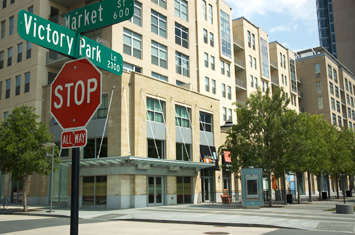Who would have thought, six years ago, that a billion-dollar investment built around a busy, well-designed arena would be brought down by the likes of a Taco Diner, Jake’s Old-Fashioned Hamburgers, and Fireside Pies? But on a recent Saturday afternoon, West Village’s outdoor tables are jammed, while on McKinney a few blocks southward pedestrians are spilling out onto the street. In the same hour, two people are visible at Victory Park, one walking a dog.
The architecture, though, is impressive. The designers can be proud. The buildings have won awards. They have been praised by architectural critics. Even an untrained eye like mine can appreciate the detail. In fact, the buildings look like architectural photographs. Unfortunately, staring up at them, they have all the characteristics of architectural photographs: they are two-dimensional, lifeless, and flat.
Jake’s, by contrast, is not pretty. It is on the first floor of a two-story, ramshackle wood-and-brick building on McKinney. It is packed with customers. Taco Diner in West Village, on the other hand, is tasteful and subdued; it sits on the first floor of a four-story stucco-and-brick building. It also is packed. Fireside Pies occupies a one-story brick building on Henderson. Its patio is full.
Consider the materials: brick, stucco, and wood. Consider the scale: not higher than four stories, surrounded by shops and restaurants at street level, and built on a similar scale. Consider the activity: there are some 25 restaurants and bars on Henderson and Knox streets; maybe 10 within a block or two of Jake’s on McKinney; at least seven in the West Village. All these places vary in size and look, but they have one thing in common. They are human. They are humble. They want you to come in.
Now consider Victory, all glass and steel, cool and angular. The architects did their best work here. Professionally, they wouldn’t glance at the Jake’s building or at Fireside Pies. Some of them even sneered to me about West Village. I wonder, though, where they go to eat.
In 1961, Jane Jacobs wrote a book called the Death and Life of Great American Cities. She had no formal architectural training and relied solely on observation. Fortunately, she had an acute eye that informed an acerbic pen. Her book eviscerates the urban planners, traffic engineers, and building designers of modern America. By applying the age-old lessons of Paris and Rome and the newer examples of Greenwich Village and neighborhoods of the Upper East Side, she figured out what makes cities work. She talked about materials and scale and density, and how humans relate to size and movement and safety in their built environment.
To see Jacobs’ ideas at work in Dallas, go to the corner of Allen and State in Uptown, and walk down either street. You will see buildings constructed at a human scale, out of natural materials, with narrow side streets. There are no police around because they aren’t needed; there are always neighbors on the sidewalks. Uptown’s developer was Robert Shaw, a self-taught student of Jacobs, and his close reading of her plainly shows in the success of the neighborhood he helped create.
Jacobs would have been appalled at Victory. It is out of scale. It is not comfortable. It does not invite. The failure of Victory has nothing to do with the retail mix, as most critics have claimed. The retailers’ problems are only symptoms. The real problem is a failure of understanding. The obstructions to enjoyment are so many that they repel rather than attract.
The designers of Victory Park may have won their prizes, but they lost their customers. It is not hard to see why. But there is still land, and if one does away with the over-designed, useless parks, there is more than enough of it to add context and flavor with humble buildings that attract rather than repel and that provide a human setting to those crisp, jewel-like skyscrapers.
A good place to start would be by reading a book written nearly 50 years ago—and taking notes while doing it.
Write to [email protected].






